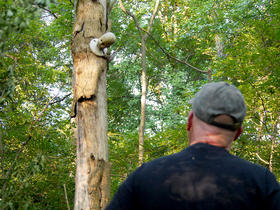History in the Trees: A Tour of the Doll’s Head Trail

We Atlanta residents may suffer an unusual sort of fatigue.
Living in a place known for continually re-making itself, and for forgetting its own history, many of us almost tire from hearing repeated claims of the “discovery” of “little-known” pieces of that history. I mean, how much forgotten history can there be?
In southeast Atlanta, there’s an entire park built atop such a piece of Atlanta’s past. It was a strange, beguiling combination of nature and history visible right beneath his feet that first attracted Joel Slaton to Constitution Lakes Park. And that’s also what drew the carpenter to transform the place, through his own strange, beguiling folk art.
WABE’s Kate Sweeney brought us this story.Broadcast version of story that ran Friday, October 3, 2014
Shortly before sunset at Constitution Lakes Park, the cicadas are in high gear. 52-year old Joel Slaton is looking out over one of the three shallow lakes that gave the park its name.
“It’s a really nice overlook,” he observes. “You see the white over there? That might be an egret. We get egrets sometimes.”
As if on cue, the bird takes off, a blur of white streaking over the swampy water about 60 yards distant. Beyond that, it’s all wooded hills. Birders and fisherman are frequent sights here. So are otter, deer, rabbits, and all the other wildlife you might expect to see in north-central Georgia.
Constitution Lakes is one of those places in Atlanta where you’d never know you’re in the city, let alone have any inkling that that this place was once an instrumental part of the city’s history. And yet it was.
Joel Slaton continues giving his tour. “This lake is from where they dug the clay out for the bricks. The rain and Mother Nature filled it in.”
This exceedingly peaceful spot was once a major quarry operation for South River Brick Company, which made bricks for Atlanta’s sewers, the Candler Building, and buildings and sidewalks all over the Southeast. The quarry went out of business in the first decade of the 1900s, but it left behind more than a trace of its existence here at the park. The chug and wail of the CSX train that echoes through the trees as it rolls past every half-hour is an eerie reminder of the rail line that was once essential to South River Brick’s operation.
Then there are the bricks themselves.
As we walk down a park trail, Joel Slaton points to the ground beside the path. “And where the ground is rumpled? It looks like rumpled carpet? It should be flat. This is all dumped brick, with trees growin’ out of it.”
It’s easy not to realize the extent of this brick until you really look at these old woods, and see that every hillock and old, upturned tree is perched atop a thick carpet of old brick and red clay pieces dumped here in the early part of the twentieth century. Walking through Constitution Lakes is a stroll through beautiful woodland, but it’s also a stroll through Atlanta history.
*
And this is what brings us to Slaton’s own story of falling on hard times—and what changed things for him a few years ago when he first discovered Constitution Lakes.
In 2008, the recession hit, and Joel’s work as a carpenter slowed to a halt. At the same time, his son, whom he calls “the center of my universe” graduated technical school and left home. Slaton was left, very suddenly, and very jarringly, unoccupied.
“So I was just casting about, trying to find something to do with myself, and I landed on this place,” he says. He discovered Constitution Lakes through a newspaper article. If it’s a little-known spot now, it was more or less invisible in 2008; there wasn’t even a sign out front back then announcing the park’s existence.
It was like a secret garden. Joel loved the nature and sense of history right beneath his feet. And soon, he began making art from that history, or more specifically, from the artifacts he found here—and eventually cleared a trail devoted to displaying that artwork.
He calls it the Doll’s Head Trail.
Today, the trail features dozens of pieces crafted from bicycle seats, fishing bobs, and scraps of clay and brick fished out from the lake and ground here. But mostly, there are the dolls. A small, plastic doll from the 1950s, its few remaining strands of plastic hair tinted blue from lake algae, perches atop a toy skateboard that Slaton found elsewhere in the park. The head of another doll is affixed to a light fixture, complete with metal chain, which hangs from a dead tree. Many of the pieces have tongue-in-cheek, punny names, like “Giving Daddy a Hand.” (This title, written in black Sharpie on a piece of clay next to two doll arms that emerge from the ground, holding up a toy truck.)
With the Doll’s Head Trail, Joel Slaton has turned this place’s history into something new, and transformed this landscape from a simple, slow takeover of an historic site by nature, into a conversation about that takeover through folk art.
Many of these pieces have an eerie edge to them. Joel says that’s because he used to believe that South River Brick used convict labor, like a lot of large companies did back at the turn of the century. Many of the convicts employed in such situations were people of color passing through town and arrested for minor things like vagrancy. Some workers died from the brutal labor. Only recently did Joel learn that South River Brick did not use convict labor—and many of his more recent pieces reflect a more whimsical mood, such as the one called “See Constitution Lakes Springs,” which includes these words scribbled on tile next to—you guessed it—an old set of metal springs.
Of course, there’s also something creepy about land that keeps yielding up the old doll parts that comprise
most of these pieces. Joel Slaton found most of these in a sunken spot he thinks was the trash pit of a family who homesteaded here in the 1950s and ‘60s, after the brickworks closed.
But there are other objects, too. Inspired by Joel’s work, visitors have made art work here from old metal
tubing, glassware, clay tiles, beer cans, and other detritus. As long as it’s made from objects found within the park, anyone can craft something on the Doll’s Head Trail. Joel Slaton has found a whole new community in the folk artists, conservationists, and neighbors he’s met here. He’s found something else, too: a new identity as an artist, although he doesn’t call himself that.
“I’ve just been a carpenter,” he says, chuckling a little. “I’ve just puttered around with a few projects at the house, but I’ve never had a conceit of anything like this…It’s just kind of like the place spoke to me. And it’s just kind of mind-boggling to me: Just some little thing I did to keep myself busy and stave off depression, turned into something I never foresaw.”
His work as a carpenter has picked up again now, but Joel’s still here at least once a week, at this wild place that changed his life, helping to transform it into something even more remarkable.
9(MDAxODM0MDY4MDEyMTY4NDA3MzI3YjkzMw004))





